technical specifications FIAT IDEA 2007 1.G Owners Manual
[x] Cancel search | Manufacturer: FIAT, Model Year: 2007, Model line: IDEA, Model: FIAT IDEA 2007 1.GPages: 314, PDF Size: 4.78 MB
Page 295 of 314
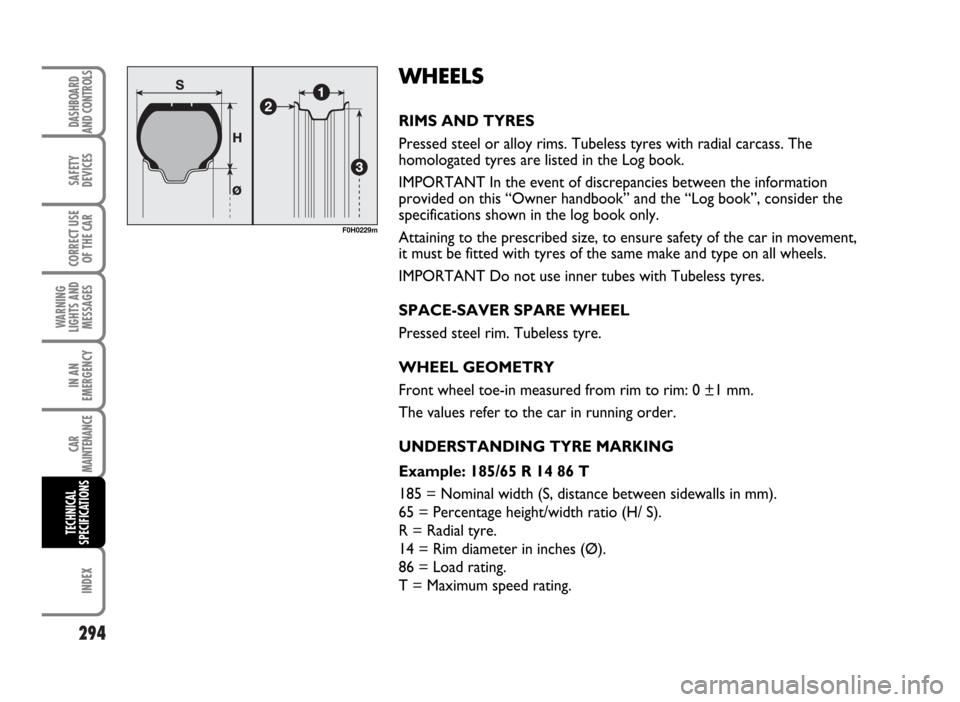
294
SAFETY
DEVICES
CORRECT USE
OF THE CAR
WARNING
LIGHTS AND
MESSAGES
IN AN
EMERGENCY
CAR
MAINTENANCE
INDEX
DASHBOARD
AND CONTROLS
TECHNICAL
SPECIFICATIONS
WHEELS
RIMS AND TYRES
Pressed steel or alloy rims. Tubeless tyres with radial carcass. The
homologated tyres are listed in the Log book.
IMPORTANT In the event of discrepancies between the information
provided on this “Owner handbook” and the “Log book”, consider the
specifications shown in the log book only.
Attaining to the prescribed size, to ensure safety of the car in movement,
it must be fitted with tyres of the same make and type on all wheels.
IMPORTANT Do not use inner tubes with Tubeless tyres.
SPACE-SAVER SPARE WHEEL
Pressed steel rim. Tubeless tyre.
WHEEL GEOMETRY
Front wheel toe-in measured from rim to rim: 0 ±1 mm.
The values refer to the car in running order.
UNDERSTANDING TYRE MARKING
Example: 185/65 R 14 86 T
185 = Nominal width (S, distance between sidewalls in mm).
65 = Percentage height/width ratio (H/ S).
R = Radial tyre.
14 = Rim diameter in inches (Ø).
86 = Load rating.
T = Maximum speed rating.
F0H0229m
Page 296 of 314
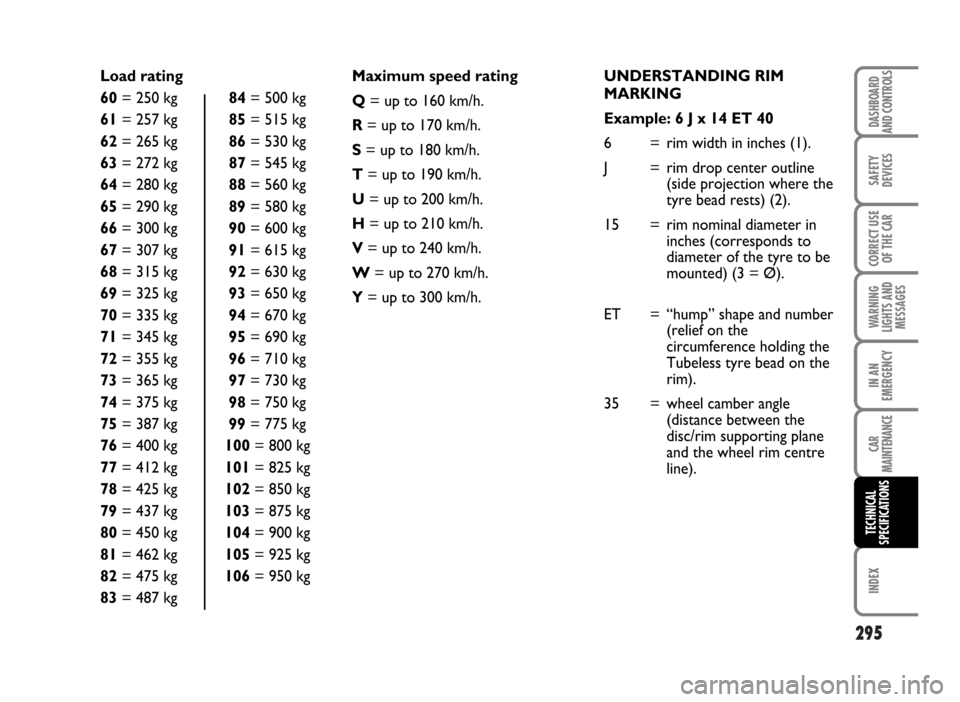
295
SAFETY
DEVICES
CORRECT USE
OF THE CAR
WARNING
LIGHTS AND
MESSAGES
IN AN
EMERGENCY
CAR
MAINTENANCE
INDEX
DASHBOARD
AND CONTROLS
TECHNICAL
SPECIFICATIONS
Load rating
60= 250 kg 84= 500 kg
61= 257 kg 85= 515 kg
62= 265 kg 86 = 530 kg
63= 272 kg 87= 545 kg
64= 280 kg 88= 560 kg
65= 290 kg 89= 580 kg
66= 300 kg 90= 600 kg
67 = 307 kg 91= 615 kg
68= 315 kg 92= 630 kg
69 = 325 kg 93 = 650 kg
70 = 335 kg 94= 670 kg
71 = 345 kg 95= 690 kg
72= 355 kg 96 = 710 kg
73= 365 kg 97= 730 kg
74 = 375 kg 98= 750 kg
75= 387 kg 99= 775 kg
76 = 400 kg 100= 800 kg
77= 412 kg 101= 825 kg
78= 425 kg 102= 850 kg
79= 437 kg 103= 875 kg
80= 450 kg 104= 900 kg
81= 462 kg 105= 925 kg
82= 475 kg 106 = 950 kg
83= 487 kgMaximum speed rating
Q= up to 160 km/h.
R= up to 170 km/h.
S
= up to 180 km/h.
T= up to 190 km/h.
U= up to 200 km/h.
H= up to 210 km/h.
V= up to 240 km/h.
W= up to 270 km/h.
Y= up to 300 km/h.
UNDERSTANDING RIM
MARKING
Example: 6 J x 14 ET 40
6 = rim width in inches (1).
J = rim drop center outline
(side projection where the
tyre bead rests) (2).
15 = rim nominal diameter in
inches (corresponds to
diameter of the tyre to be
mounted) (3 = Ø).
ET = “hump” shape and number
(relief on the
circumference holding the
Tubeless tyre bead on the
rim).
35 = wheel camber angle
(distance between the
disc/rim supporting plane
and the wheel rim centre
line).
Page 297 of 314

296
SAFETY
DEVICES
CORRECT USE
OF THE CAR
WARNING
LIGHTS AND
MESSAGES
IN AN
EMERGENCY
CAR
MAINTENANCE
INDEX
DASHBOARD
AND CONTROLS
TECHNICAL
SPECIFICATIONS
COLD TYRE INFLATION PRESSURE (bar)
STANDARD TYRES
Size Medium load Full load
Front Rear Front Rear
RIMS
6J x 14” ET 40
6J x 15” ET 40 (*)
6
1/2J x 16” ET 40 (alloy)
6J x 15” ET 40 (*)
6
1/2J x 16” ET 40 (alloy)
Standard
185/65 R14 86T
195/60 R15 88T
205/50 R16 87V (**)
195/60 R15 88T
205/50 R16 87V (**)
Snow
185/65 R14 86Q (M+S)
195/60 R15 88Q (M+S)
–
195/60 R15 88Q (M+S)
–
Rim
4B x 14” (***)
4B x 15”
4B x 15”
Tyre
135/80 B14 84M (***)
125/80 R15 95M
125/80 R15 95M
TYRES SPACE-SAVER SPARE
1.2 - 1.4 petrol
and 1.3 Multijet
70HP
1.3 Multijet 90HP
and 1.9 Multijet
(*) Optional alloy rim - (**) Tyres cannot be fitted with snow chains
(***) IMPORTANT: 14” wheel can only be used on 1.2-1.4 petrol type and 1.3 Multijet 70 HP cars with a chassis number greater
than 74500
or
185/65 R14 86T 2.2 2.1 2.3 2.3
195/60 R15 88T 2.2 2.1 2.3 2.3
205/50 R16 87V 2.2 2.1 2.3 2.3
135/80 B14 84M 2.8SPARE WHEEL
125/80 R15 95M 4.2
Add +0.3 bar to the prescribed inflation pressure when the tyres are warm. Recheck pressure value with cold tyres.
With snow tyres, add +0.2 bar to the inflation pressure value prescribed for standard tyres.
VERSIONS
Page 298 of 314
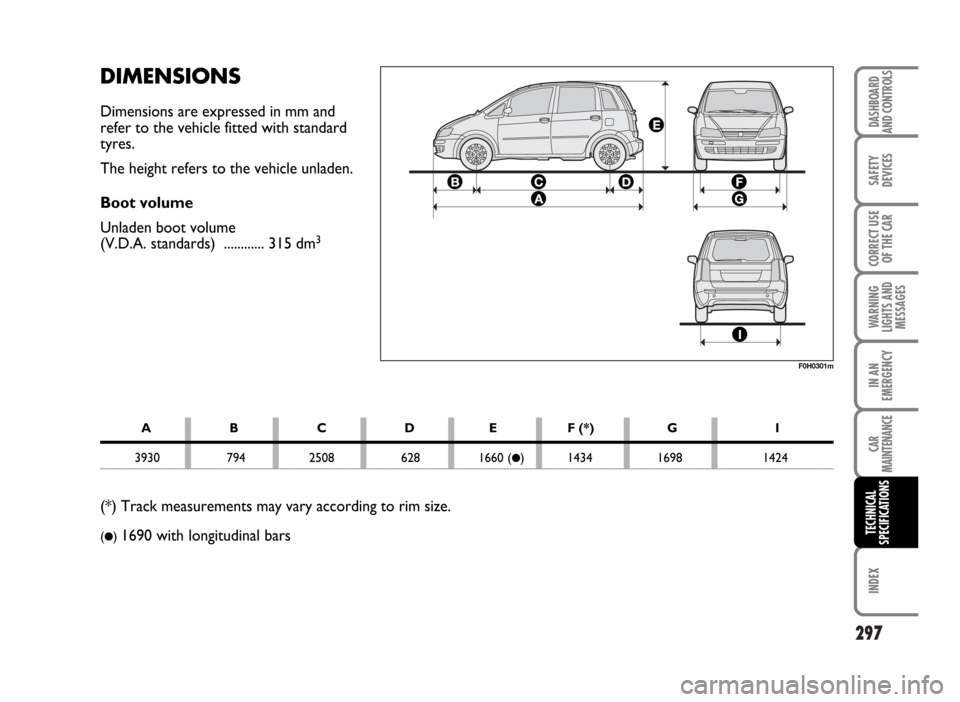
297
SAFETY
DEVICES
CORRECT USE
OF THE CAR
WARNING
LIGHTS AND
MESSAGES
IN AN
EMERGENCY
CAR
MAINTENANCE
INDEX
DASHBOARD
AND CONTROLS
TECHNICAL
SPECIFICATIONS
DIMENSIONS
Dimensions are expressed in mm and
refer to the vehicle fitted with standard
tyres.
The height refers to the vehicle unladen.
Boot volume
Unladen boot volume
(V.D.A. standards) ............ 315 dm
3
A B C D E F (*) G I
3930 794 2508 628 1660 (●) 1434 1698 1424
(*) Track measurements may vary according to rim size.
(●)1690 with longitudinal bars
F0H0301m
Page 299 of 314
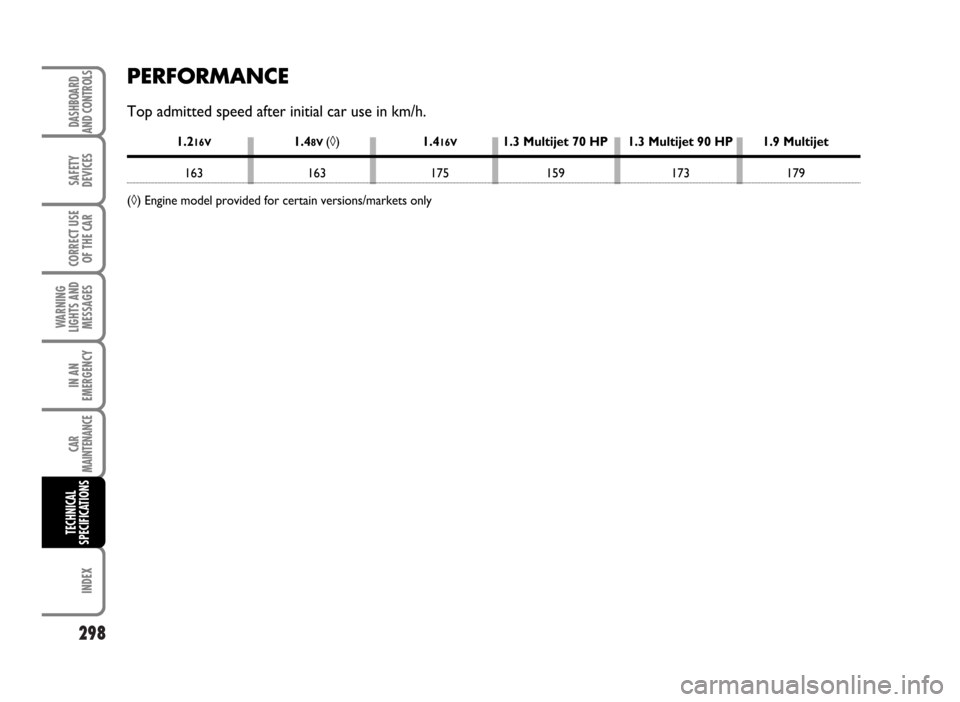
298
SAFETY
DEVICES
CORRECT USE
OF THE CAR
WARNING
LIGHTS AND
MESSAGES
IN AN
EMERGENCY
CAR
MAINTENANCE
INDEX
DASHBOARD
AND CONTROLS
TECHNICAL
SPECIFICATIONS
PERFORMANCE
Top admitted speed after initial car use in km/h.
1.216V1.48V (◊)1.416V1.3 Multijet 70 HP 1.3 Multijet 90 HP 1.9 Multijet
163 163 175 159 173 179
(◊) Engine model provided for certain versions/markets only
Page 300 of 314
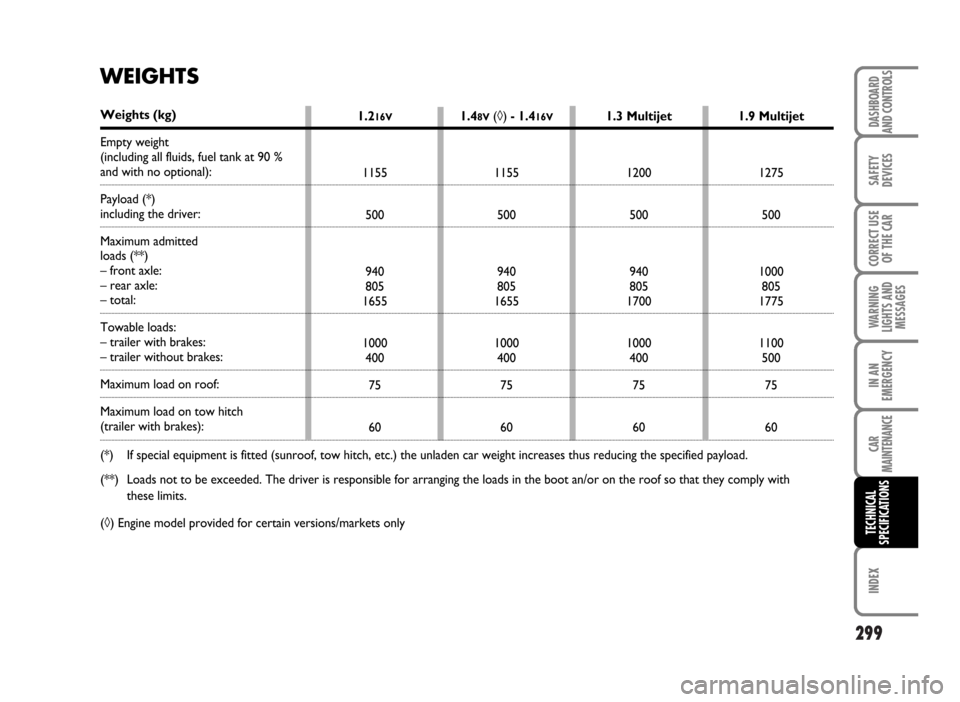
299
SAFETY
DEVICES
CORRECT USE
OF THE CAR
WARNING
LIGHTS AND
MESSAGES
IN AN
EMERGENCY
CAR
MAINTENANCE
INDEX
DASHBOARD
AND CONTROLS
TECHNICAL
SPECIFICATIONS
1.216V
1155
500
940
805
1655
1000
400
75
601.4
8V(◊) - 1.416V
1155
500
940
805
1655
1000
400
75
601.3 Multijet
1200
500
940
805
1700
1000
400
75
60
1.9 Multijet
1275
500
1000
805
1775
1100
500
75
60
WEIGHTS
Weights (kg)
Empty weight
(including all fluids, fuel tank at 90 %
and with no optional):
Payload (*)
including the driver:
Maximum admitted
loads (**)
– front axle:
– rear axle:
– total:
Towable loads:
– trailer with brakes:
– trailer without brakes:
Maximum load on roof:
Maximum load on tow hitch
(trailer with brakes):
(*) If special equipment is fitted (sunroof, tow hitch, etc.) the unladen car weight increases thus reducing the specified payload.
(**) Loads not to be exceeded. The driver is responsible for arranging the loads in the boot an/or on the roof so that they comply with
these limits.
(◊) Engine model provided for certain versions/markets only
Page 301 of 314
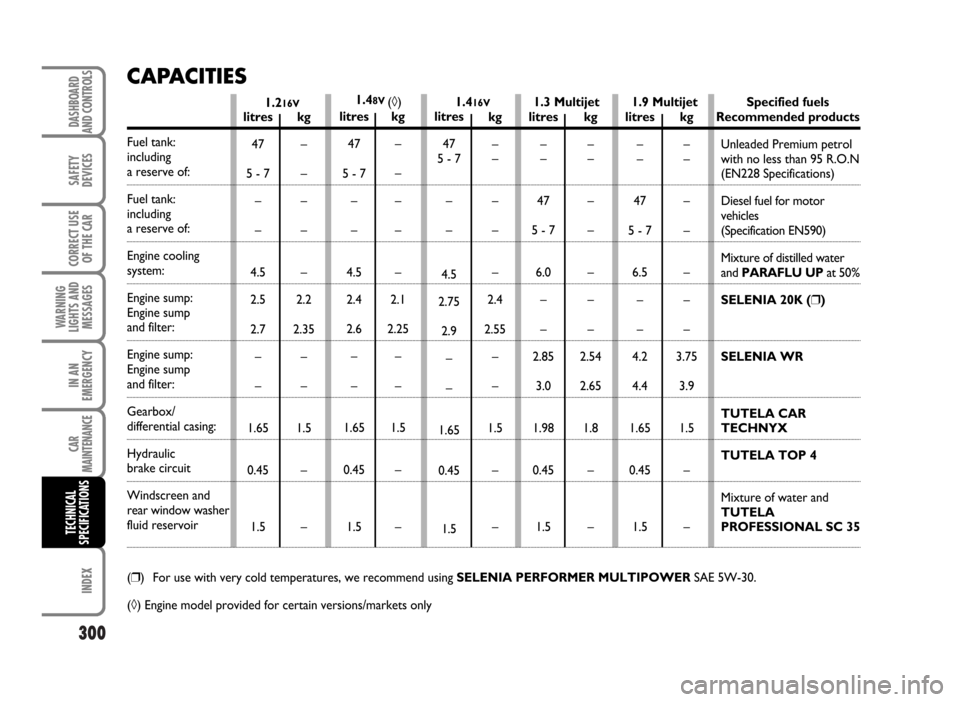
300
SAFETY
DEVICES
CORRECT USE
OF THE CAR
WARNING
LIGHTS AND
MESSAGES
IN AN
EMERGENCY
CAR
MAINTENANCE
INDEX
DASHBOARD
AND CONTROLS
TECHNICAL
SPECIFICATIONS
1.416V1.216V1.3 Multijet
kg
–
–
–
–
–
2.4
2.55
–
–
1.5
–
–kg
–
–
–
–
–
–
–
2.54
2.65
1.8
–
–litres
–
–
47
5 - 7
6.5
–
–
4.2
4.4
1.65
0.45
1.5kg
–
–
–
–
–
–
–
3.75
3.9
1.5
–
–litres
47
5 - 7
–
–
4.5
2.75
2.9
–
–
1.65
0.45
1.5 litres
47
5 - 7
–
–
4.5
2.5
2.7
–
–
1.65
0.45
1.5kg
–
–
–
–
–
2.2
2.35
–
–
1.5
–
–litres
–
–
47
5 - 7
6.0
–
–
2.85
3.0
1.98
0.45
1.51.9 Multijet1.48V (◊)
litres
47
5 - 7
–
–
4.5
2.4
2.6
–
–
1.65
0.45
1.5kg
–
–
–
–
–
2.1
2.25
–
–
1.5
–
–
CAPACITIES
Fuel tank:
including
a reserve of:
Fuel tank:
including
a reserve of:
Engine cooling
system:
Engine sump:
Engine sump
and filter:
Engine sump:
Engine sump
and filter:
Gearbox/
differential casing:
Hydraulic
brake circuit
Windscreen and
rear window washer
fluid reservoir
(❒) For use with very cold temperatures, we recommend using SELENIA PERFORMER MULTIPOWERSAE 5W-30.
(◊) Engine model provided for certain versions/markets onlySpecified fuels
Recommended products
Unleaded Premium petrol
with no less than 95 R.O.N
(EN228 Specifications)
Diesel fuel for motor
vehicles
(Specification EN590)
Mixture of distilled water
and PARAFLU UPat 50%
SELENIA 20K (❒)
SELENIA WR
TUTELA CAR
TECHNYX
TUTELA TOP 4
Mixture of water and
TUTELA
PROFESSIONAL SC 35
Page 302 of 314
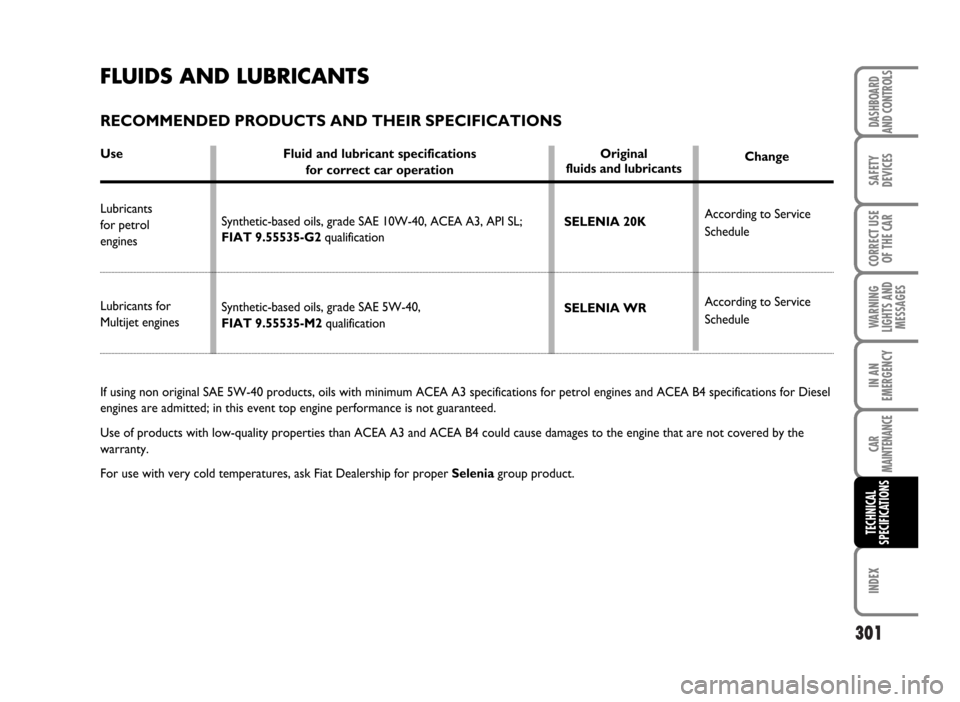
301
SAFETY
DEVICES
CORRECT USE
OF THE CAR
WARNING
LIGHTS AND
MESSAGES
IN AN
EMERGENCY
CAR
MAINTENANCE
INDEX
DASHBOARD
AND CONTROLS
TECHNICAL
SPECIFICATIONS
Fluid and lubricant specifications
for correct car operation
Synthetic-based oils, grade SAE 10W-40, ACEA A3, API SL;
FIAT 9.55535-G2 qualification
Synthetic-based oils, grade SAE 5W-40,
FIAT 9.55535-M2 qualificationOriginal
fluids and lubricants
SELENIA 20K
SELENIA WRChange
According to Service
Schedule
According to Service
Schedule
FLUIDS AND LUBRICANTS
RECOMMENDED PRODUCTS AND THEIR SPECIFICATIONS
Use
Lubricants
for petrol
engines
Lubricants for
Multijet engines
If using non original SAE 5W-40 products, oils with minimum ACEA A3 specifications for petrol engines and ACEA B4 specifications for Diesel
engines are admitted; in this event top engine performance is not guaranteed.
Use of products with low-quality properties than ACEA A3 and ACEA B4 could cause damages to the engine that are not covered by the
warranty.
For use with very cold temperatures, ask Fiat Dealership for properSeleniagroup product.
Page 303 of 314
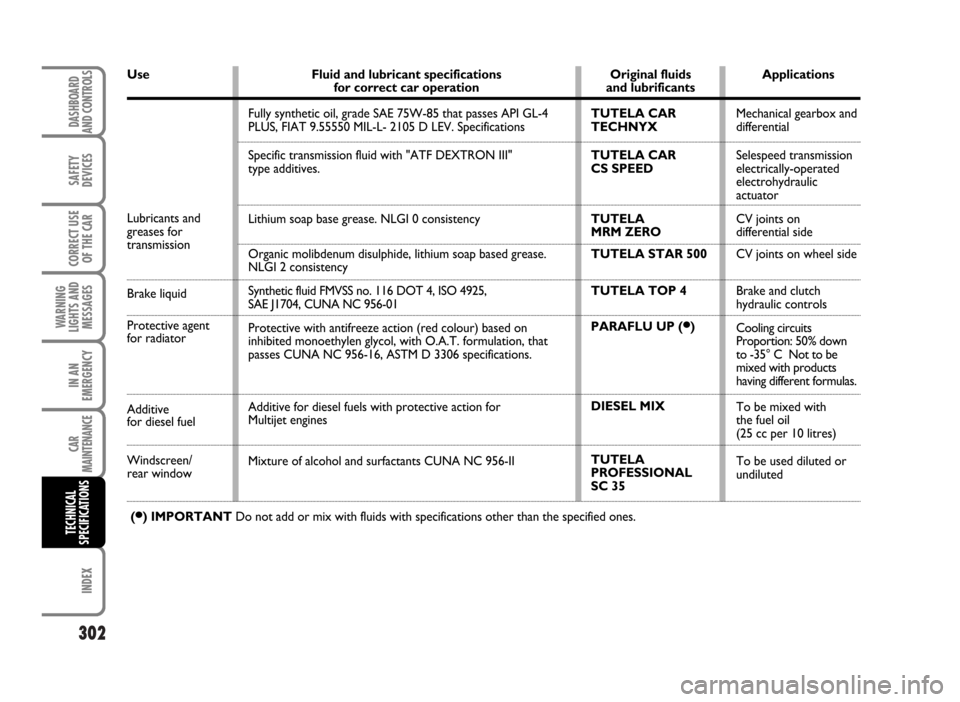
302
SAFETY
DEVICES
CORRECT USE
OF THE CAR
WARNING
LIGHTS AND
MESSAGES
IN AN
EMERGENCY
CAR
MAINTENANCE
INDEX
DASHBOARD
AND CONTROLS
TECHNICAL
SPECIFICATIONS
Use
Lubricants and greases for
transmission
Brake liquid
Protective agent
for radiator
Additive
for diesel fuel
Windscreen/
rear window
(●) IMPORTANT Do not add or mix with fluids with specifications other than the specified ones.Fluid and lubricant specifications
for correct car operation
Fully synthetic oil, grade SAE 75W-85 that passes API GL-4
PLUS, FIAT 9.55550 MIL-L- 2105 D LEV. Specifications
Specific transmission fluid with "ATF DEXTRON III"
type additives.
Lithium soap base grease. NLGI 0 consistency
Organic molibdenum disulphide, lithium soap based grease.
NLGI 2 consistency
Synthetic fluid FMVSS no. 116 DOT 4, ISO 4925,
SAE J1704, CUNA NC 956-01
Protective with antifreeze action (red colour) based on
inhibited monoethylen glycol, with O.A.T. formulation, that
passes CUNA NC 956-16, ASTM D 3306 specifications.
Additive for diesel fuels with protective action for
Multijet engines
Mixture of alcohol and surfactants CUNA NC 956-IIOriginal fluids
and lubrificants
TUTELA CAR
TECHNYX
TUTELA CAR
CS SPEED
TUTELA
MRM ZERO
TUTELA STAR 500
TUTELA TOP 4
PARAFLU UP (
●)
DIESEL MIX
TUTELA
PROFESSIONAL
SC 35Applications
Mechanical gearbox and
differential
Selespeed transmission
electrically-operated
electrohydraulic
actuator
CV joints on
differential side
CV joints on wheel side
Brake and clutch
hydraulic controls
Cooling circuits
Proportion: 50% down
to -35° C Not to be
mixed with products
having different formulas.
To be mixed with
the fuel oil
(25 cc per 10 litres)
To be used diluted or
undiluted
Page 304 of 314
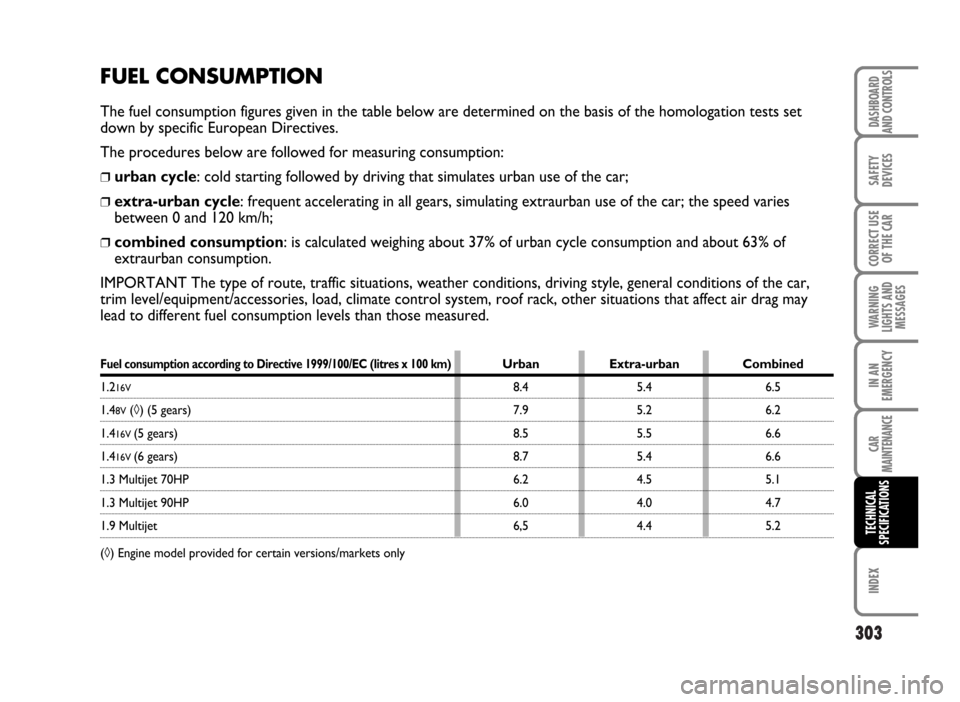
303
SAFETY
DEVICES
CORRECT USE
OF THE CAR
WARNING
LIGHTS AND
MESSAGES
IN AN
EMERGENCY
CAR
MAINTENANCE
INDEX
DASHBOARD
AND CONTROLS
TECHNICAL
SPECIFICATIONS
FUEL CONSUMPTION
The fuel consumption figures given in the table below are determined on the basis of the homologation tests set
down by specific European Directives.
The procedures below are followed for measuring consumption:
❒urban cycle: cold starting followed by driving that simulates urban use of the car;
❒extra-urban cycle: frequent accelerating in all gears, simulating extraurban use of the car; the speed varies
between 0 and 120 km/h;
❒combined consumption: is calculated weighing about 37% of urban cycle consumption and about 63% of
extraurban consumption.
IMPORTANT The type of route, traffic situations, weather conditions, driving style, general conditions of the car,
trim level/equipment/accessories, load, climate control system, roof rack, other situations that affect air drag may
lead to different fuel consumption levels than those measured.
Fuel consumption according to Directive 1999/100/EC (litres x 100 km)Urban Extra-urban Combined
1.216V8.4 5.4 6.5
1.48V(◊) (5 gears) 7.9 5.2 6.2
1.416V (5 gears) 8.5 5.5 6.6
1.416V (6 gears) 8.7 5.4 6.6
1.3 Multijet 70HP 6.2 4.5 5.1
1.3 Multijet 90HP 6.0 4.0 4.7
1.9 Multijet 6,5 4.4 5.2
(◊) Engine model provided for certain versions/markets only